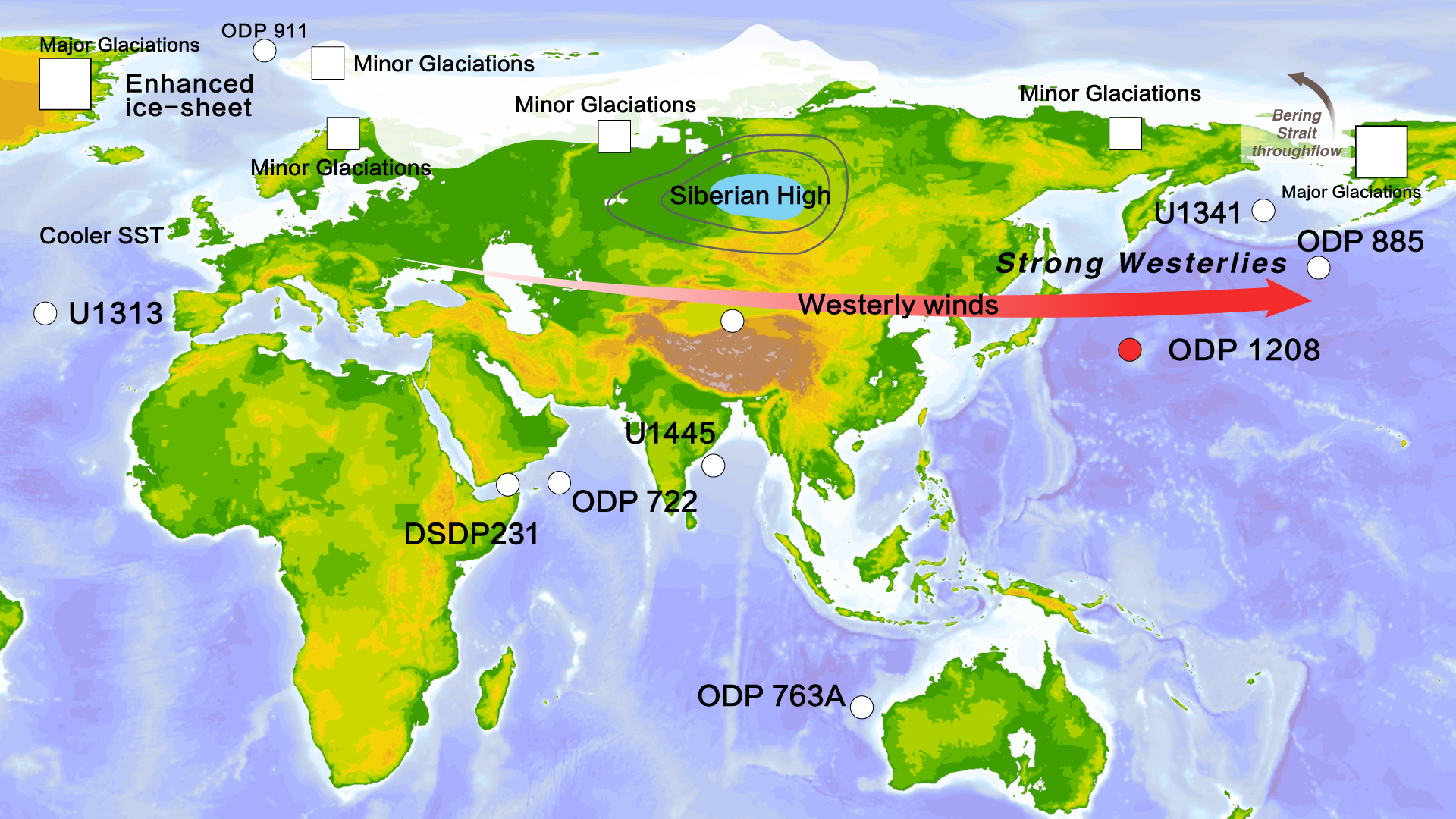In the last few tens of millions of years (Ma, mega annum), the Earth formed an ice sheet in the Antarctic at 33 Ma. The Northern Hemisphere ice sheet has been expanding in the last few million years. In recent decades, due to global warming, ice sheet retreat, and sea ice melt have occurred in the Arctic region, which significantly impacts the global climate environment. It is critical and urgent to study the establishment mechanism and evolution process of the Arctic ice sheet for understanding the global climate system and predicting of future climate change.
Previous studies have suggested that the establishment and expansion process of the Arctic ice sheet mainly involves the influence of atmospheric CO2 decline, the weakening of water mass ventilation in the polar regions, and ocean strait closure. However, there has been a lack of understanding of the role of ocean-land interaction in the Earth’s climate system and feedback mechanism.
To clarify the ocean-land coupling process, the marine sediments of the North Pacific Ocean contain abundant information about the dust source region of East Asia and Central Asia and the dynamic process of the westerlies. Previous studies have shown that enhanced dust deposition in the North Pacific is associated with the formation of permanent ice sheets in the 2.74~2.72 Ma. Still, the entire process of the formation and expansion of the Northern Hemisphere ice sheet remains unknown.

To address this puzzle, a research team from the Centre for Marine Magnetism (CM2) of the Department of Marine Science and Engineering at the Southern University of Science and Technology (SUSTech) has revealed the role of land-ocean interactions in stepwise Northern Hemisphere Glaciation. They provide insights into the role of ocean-land feedback processes in the Earth’s climate system and new feedback mechanism for the formation and expansion of ice sheets in the Northern Hemisphere.
Their paper, entitled “Role of land of interactions in stepwise Northern Hemisphere Glaciation”, has been published in Nature Communications, a leading Nature Series journal in the field of Earth Sciences.
In recent years, the research team has carried out a lot of work in North Pacific chronology, establishing new dust indicators and the application of the formation mechanism and dynamic processes of dust in the North Pacific on different timescales. Through the reconstruction of high-resolution records from ODP 1208 sediment during ODP 198. A multi-stage evolution model of ocean-land coupling in the formation and expansion of ice sheets in the Northern Hemisphere was proposed through terrestrial vegetation and atmospheric circulation.
In summary, there were three important innovations in this work. Firstly, to point out that the enhancement time of Pliocene eolian dust flux should be earlier than 2.75 million years ago, starting from the Pliocene glacial M2 stage (3.3 million years ago); Secondly, to describe the ocean-atmosphere interaction process in the Northern Hemisphere during the formation and expansion of the Northern Hemisphere ice sheet; Lastly, to further support that the enhancement of meridional temperature gradient caused by the northern Hemisphere ice sheet is the main factor of the enhancement of the westerlies. The researchers further emphasized that the land-ocean coupling process during the global atmospheric circulation intensified the transformation of global terrestrial vegetation types, which may directly lead to the transformation of the global carbon reservoir and further trigger global cooling.
In the context of future global warming, due to the effect of polar amplification, the high latitudes in the Northern Hemisphere will be warmer than the low latitudes. This will lead to the melting of the Greenland ice sheet, making the Atlantic meridional overturning continue to weaken or even sluggish. Therefore, a comprehensive understanding of the feedback mechanism of different layers in the climate system could provide important references for future climate changes and model simulation.
Dr. Yi Zhong from the Department of Ocean Science and Engineering at SUSTech is the first author of this paper. Prof. Qingsong Liu and Dr. Ning Tan are the corresponding authors.
This work was supported by the National Natural Science Foundation of China, State Key Laboratory of Marine Geology, Shenzhen Science and Technology Program, and the High Level Special Fund of SUSTech. ODP Site 1208 core samples were provided by the Integrated Ocean Drilling Program (IODP).
Paper link: https://doi.org/10.1038/s41467-024-51127-w
To read all stories about SUSTech science, subscribe to the monthly SUSTech Newsletter.
Proofread ByAdrian Cremin, Yingying XIA
Photo ByJiahui LI